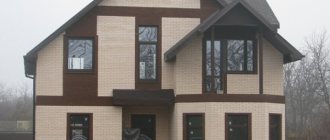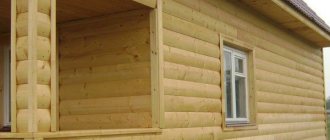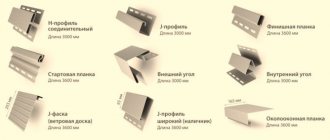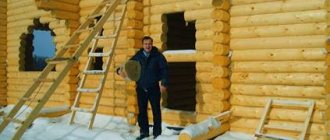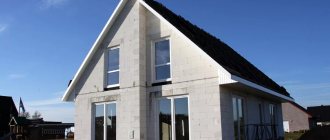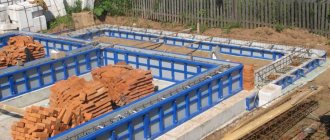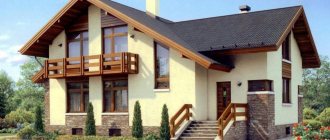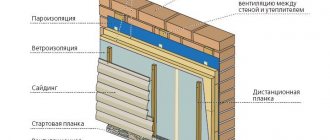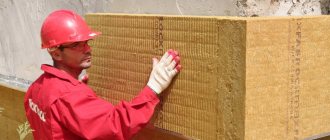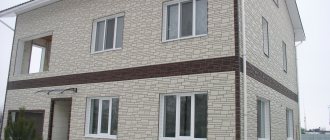Design features of facade systems
All types of facade finishing can be divided into two groups:
- thermal insulation – multilayer systems based on insulation, designed to minimize heat loss, increase energy efficiency and decorativeness of the building;
- protective and decorative - multi-layer systems or single-layer materials to protect the building envelope from external factors and increase the attractiveness of the house.
Both thermal insulation and protective and decorative facades come in two types:
- wet - the device technology involves the use of construction and finishing mixtures (masonry mortar, adhesive mixtures, rough plaster, decorative plaster);
- hinged - fixation of system elements is carried out mechanically, in a dry way, using subsystems (lathing, counter-lattice) and hardware (screws, dowels, clamps).
Curtain facades with thermal insulation are always ventilated - air circulation from bottom to top is necessary to maintain the insulation in a dry state. If we are talking about a hinged protective and decorative facade, a ventilation gap is not needed; the cladding is attached either directly to the base or to a subsystem.
Why do you need exterior decoration of a house, its main purpose?
The material for cladding the outside of the house should be selected at the stage of creating the building project. With the help of external finishing, you can strengthen the old facade and return it to a neat appearance. If we are talking about restoring an old building, then the choice of material should be approached with greater responsibility, since it should not only look aesthetically pleasing, have high-quality characteristics, but also be compatible with the material from which the walls are made.
Sheathing the outside of the house helps strengthen and insulate the job
Important! The building material purchased for the construction of the box must be less permeable. This is necessary for the reason that the thermal insulation layer is considered less susceptible to vapor than the building material used for exterior wall decoration. Almost all materials except natural wood have a low heat transfer index.
If you choose a material for construction that does not have the required vapor permeability, most likely, condensation will accumulate at the boundaries of the layers. This will cause fungus to multiply, mold to appear, and surfaces to rot. At low ambient temperatures, leaked moisture will begin to freeze. This will lead to the expansion of small cracks and slow destruction of the walls. An incorrectly executed façade will have to be replaced after just a few years of operation. To establish air circulation inside the facade, you can use one of the following methods:
- Organize a ventilated façade. In this case, permeable thermal insulation with ventilated gaps is laid between the wall and the finishing material. So, if we are talking about a facade of 20 m², including window and door openings, the gap volume should be at least 75 cm².
- Protect the inside of the wall with an additional vapor barrier layer. With this option, the facing material is attached directly to the wall of the house without any backing. The inner layer prevents moisture from escaping onto the surface of the wall and finish.
Thanks to facade finishing, you can make an old building more presentable
After installing the ventilated layer, the top of the gaps is left open to allow vapors to escape. In this case, the exterior decoration of a private house plays both a protective and decorative function.
With the advent of high-quality insulating materials for interior wall decoration, the second method of protecting walls began to be used much more often. Typically, polystyrene foam is attached to the inside, which is characterized by low vapor permeability and is an effective heat insulator. By insulating the inside of the wall with it, you can significantly save on heating the room. In such a situation, the facade can be faced using any material, be it wooden beams or porcelain tiles.
Types of facade finishing
Houses of the previous generation could not boast of a wide variety of facades - red brick cladding (ceramics), white brick cladding (silicate), cement-sand plaster coat, paint (panel and wooden houses). Considering that they were built primarily from brick, panels and logs, there was no particular need for other finishing options. With the advent of frame technology and various large-format blocks aimed at mandatory finishing, demand has increased and supply has appeared. The classics have not gone away, both brick and wooden housing construction are at their peak, but several spectacular and effective ways to protect and transform buildings have been added. It is problematic to list all the possible options for decorative finishing of the facade of a house; something original always appears, so let’s look at the most popular ones.
- Siding.
- Facade panels.
- Wood cladding.
- Decorative plaster.
- Brick cladding.
- Tiles on the facade.
- Stone cladding.
Finishing with natural and artificial stone
The beauty of the façade will be ensured by natural and artificial stone for many years. Materials for wall cladding are made in the form of slabs with smooth, rough and textured coating.
Facade slabs made of natural stone are formed by processing the following materials:
- marble;
- granite and syenite;
- limestone and sandstone;
- slate;
- dolomite;
- quartzite;
- gabbro;
- labradorite;
- purple;
- breccias.
Artificial stone is produced by molding a mixture of cement, sand and stone chips of various fractions. Expanded clay, ceramic chips, natural pumice and expanded perlite are used for crushing.
When making artificial stone slabs, the finished products at first glance do not differ from natural ones, but they have less weight. In addition, the collection of facade coverings made of artificial stone has absolutely fantastic colors, shades and textures.
To cover the facade with stone panels, it must be prepared so that the maximum surface unevenness does not exceed 2 cm. After preparing and cleaning the wall, the reinforcing mesh is fixed. Next, the tiles are laid on the facade using cement mortar.
To prevent the plate from falling off or breaking when moving away from the mortar, a stainless wire should be attached to the back side of the product, the other end of which should be tied to the reinforcing mesh
In the manufacture of artificial slabs, natural stone chips, high-grade cement and clean sand are used.
Therefore, the material created in industrial conditions and natural rocks have the same advantages, which include:
- Strength , resistance to any deformation.
- Durable , fade resistant.
- Resistance to temperature changes and precipitation.
The main disadvantage of facade stone is its high price. The most expensive materials are granite and marble, the most affordable are sandstone, limestone and artificial analogues of natural stone slabs.
Siding
This category unites a large group of materials for facade cladding with common characteristic features:
- long typesetting panels imitating a wooden board or log;
- fixation of type-setting elements with hardware to a wooden, metal or polymer subsystem (curtain façade);
- high decorativeness - the cladding does not require additional manipulations; after assembly, a completed facade is obtained without the need for treatment with protective and decorative compounds.
Modern siding comes in several varieties.
Vinyl
Produced from polyvinyl chloride (PVC) using the extrusion method, previously the material was characterized by low color fastness and fragility. Today's polymers have improved significantly technically; even in dark collections, the color saturation remains for years, and the resistance to mechanical stress is an order of magnitude higher. In addition to regular vinyl siding, manufacturers offer foam siding, which is thicker, stronger and more durable. Both vinyl and foam siding have a number of advantages.
- Presentable – a large selection of textures and colors, a fairly high level of imitation, thanks to the textured surface.
- Durability - the polymer is resistant to temperature, moisture, and is not subject to corrosion.
- Versatility - due to its low weight and installation method, it can be used on almost any type of base, both with and without insulation.
- Ease of installation - assembly of the subsystem and the cladding itself does not require expensive equipment and professional skills; you can do it yourself. Due to the absence of wet processes, facade finishing with siding is carried out almost all year round.
Three times DadForumHouse Member
Vinyl siding, herringbone, blueberry, the facade was made by myself, on a wooden block.
The disadvantages of siding are largely related to its quality - budget cladding can fade, crack in the cold, and can warp and warp due to severe overheating. Not everyone likes the appearance of siding, but this is purely a matter of taste and financial capabilities; the original is always cooler than the imitation, but also more expensive.
Metal
Corrosion-resistant aluminum siding is the prerogative of public buildings; in the private sphere it is used in combined facades, in fragments. As the main cladding, steel siding with a polymer protective and decorative coating is in demand. Metal also imitates natural wood, most often it is a board, beam, block house or log, but only in profile and pattern, and not in texture. The advantages of metal siding include durability with decorativeness, and versatility with ease of installation. Plus, the metal is not afraid of mechanical stress, does not burn or crack in the cold, and even exceeds its vinyl counterparts in terms of service life.
viktor5000FORUMHOUSE Member
I started decorating at the beginning of winter, half of the house is ready. I’m posting photos for variety, otherwise when I was looking for options, there were few samples on the Internet. Metal is absolutely everywhere: the roof, walls, soffits and trim on windows and doors. There is not a single plastic part.
But damage to the protective layer during installation or operation is fraught with the appearance of corrosion, and rust does not paint any façade. During the work, extreme care must be taken so as not to block all the advantages of the material by careless installation.
Fiber cement
It is made from a mixture of cement binder and reinforcing fiber (fiber, mainly cellulose, but other inclusions are possible) by autoclave hardening. The production cycle allows us to obtain a surface that is as close as possible to wood in texture. The installation technology is standard, usually a wooden or metal subsystem; extensions can be either special or homemade. Fiber cement on the facade is combined with natural wood, stone and plaster. The strength, durability and wear resistance of fiber cement boards is higher than that of vinyl, while metal is inferior in reliability, but this type of siding is the most expensive in terms of cost. The relatively large mass (15-18 m²) is not a drawback; any foundation, be it a monolith, masonry or wooden frame, can withstand such weight. Installation of fiber cement cladding is somewhat more complicated, since the boards are only single and cutting is more labor-intensive, but it is also quite possible to carry out all the manipulations on your own.
Ilya1005FORUMHOUSE Member
The house was covered with fiber cement siding; the workers liked the material. For those who are just going to do this: don’t use branded paint for the ends, you can tint acrylic water-dispersed paint in the desired color, it will be a lot cheaper. Self-tapping screws are also excellent in the hypermarket (800 rubles for 500 pcs.) The manufacturing company has self-tapping screws for 3,200 rubles for 500. You can save a little.
Siding for facing a house
The most affordable option for finishing a house is siding. The material has a lower cost than wood, lumber, ceramics, has a long service life, and therefore is used much more often than other facade coatings.
Siding can be used to cover walls built from any material with any type of external insulation. A facade equipped in this way is ventilated, since the materials are mounted on a prepared sheathing, so this coating is universal.
Option No. 1 - vinyl panels
Vinyl siding is made from high-tech polyvinyl chloride, which is used in various climate zones. It can be easily cut to form the correct facade of houses with uneven walls, protrusions, and many decorative elements.
The material is flat strips 10-12 mm thick, 205-255 mm wide. The siding is attached to the facade using a perforation line for fastening and docking locks connecting the two panels to each other.
When installing siding on the facade of a house, use several shades of the material, choose dark shades for corners, window sills, and the foundation of the house so that the building does not look boring and monotonous
Installation of vinyl strips is carried out on a metal or impregnated wooden sheathing, consisting of starting and side additional beams. The screws are screwed in in such a way that there is some play left for possible changes in the siding under the influence of temperatures.
A type of vinyl panels is basement siding. Only in this case, the panels do not look like stripes, but like a square or rectangular part of the wall.
The material is thicker than vinyl panels, as it is designed to protect the roof base from precipitation and other influences. But because of its practicality and strength, it has become widespread when cladding facades.
The basement facade is attached to the sheathing, which is attached more tightly, due to the fact that the panels have the shape of a square or rectangle of shorter length.
To match the pattern, additional fastening beams may be needed during direct work with the material. Please take this into account when purchasing materials for sheathing.
To mount the panels, each panel has perforation and a connecting lock. When screwing in self-tapping screws, you should leave some play to compensate for possible movements of the material.
Basement siding imitates natural materials better than others. Therefore, with skillful installation, it is possible to distinguish an artificial facade from a wall made of stone or brick only by directly touching the wall.
The advantages of vinyl siding are:
- Easy installation on buildings of any configuration.
- Affordable price of material.
- Installation of a façade made of vinyl siding is possible at temperatures from -5 to +40 °C.
The disadvantages include rapid fading on the sunny side of the building, so it is better to choose light shades of panels. In addition, installation at low temperatures from -5 ° C will increase the number of trims, since the siding will burst with minor bends during processing.
Option No. 2 - metal siding
Metal siding is made from aluminum or galvanized steel. A dye is applied to the surface to perform a protective function.
The material is decorated in two ways:
- Covered with a polymer shell. Such panels do not fade and are resistant to mechanical stress. During polymerization, manufacturers use a limited number of shades.
- Powder painted. With this treatment, the paint does not fade and can be used for a long time at any temperature without signs of peeling. The panels have a variety of colors and shades.
Installation of metal panels is carried out on load-bearing and additional side beams using self-tapping screws and connecting locks on the strips.
Metal siding comes in a variety of textures and colors. A house made of such material can be similar to housing made of timber, ship planks, logs, wild stone, brick
The advantages of such panels include their low price, durable coloring without fading of colors on the sunny side of the building. In addition, metal panels are easy to work with at any time of the year, they bend well, do not break, and are suitable for cladding round structures.
The disadvantage is the aesthetic simplicity of metal strips. If the installation is unsuccessful, the building looks more like a production workshop.
Facade panels
Initially produced specifically for the base, they are characterized by increased strength and resistance to all types of influences, from atmospheric to mechanical. If the siding imitates wood, both in shape and appearance, then the panels repeat fragments of brick or stone cladding; there are also collections for a plaster facade, but less often. The surface can be either smooth, like facing ceramic bricks, or textured, like hand-molded bricks and various types of stone. Panels, like siding, are of several types.
- Polymer - apart from the type, they differ from vinyl siding in greater thickness.
- Fiber cement - the only difference is in shape and texture.
DusyaChashkinaFORUMHOUSE participant
The facade is finished with panels - Japanese, fiber cement, metal subsystem, expensive, but beautiful. All that remains is to finish the blind area. I'm happy with the result!
It is worth considering thermal panels separately, since this relatively new material for facade finishing is both insulation and decorative screen. Unlike polymer and fiber cement panels, thermal panels are fixed directly to the base with glue (adhesive foam) and mechanically, without a subsystem. The thermal insulation layer can be polystyrene foam (EPS), extruded polystyrene foam (EPS, XPS) or polyurethane foam (PPU). The front decorative part is usually made of clinker or ceramic tiles, printed concrete or flexible stone (a combination of acrylic polymer and quartz sand or marble chips).
Vyacheslav715FORUMHOUSE Member
A frame house (OSB exterior cladding) was lined with thermal panels made of polystyrene foam (60 mm) with German clinker tiles in 2003. There are no defects in the facade. It hasn’t been opened, but there are no signs of damage (odor, mold, etc.) in the house, photo – winter 2021.
Types of decorative cladding
Modern materials make it possible to create an imitation of brickwork on a wooden wall, or vice versa - to transform a brick house into a wooden frame. For this, claddings such as siding made of different materials, wooden lining, block house, thermal panels, ceramic or stone tiles and others are used. It is necessary to find out in advance how each of the skins is attached and what it looks like in the end - this will largely determine which insulation system to choose for it.
Clinker thermal panels
Clinker thermal panels are one of the modern materials for insulation and decoration of facades.
House covered with clinker thermal panels
They have appeared on the construction market relatively recently, and have already gained wide popularity. This is not at all surprising, since they have many positive qualities.
- One of the main advantages is that this material performs two functions at once: insulation and decorative cladding.
- The panels perfectly imitate brickwork and are produced in a variety of colors, so they can be matched to any style and taste.
- They give the surface absolute neatness and aesthetics.
- This type of cladding is convenient and relatively easy to install on the wall.
- Thermal panels can be used to cover any surface - wood or brick.
- The light weight of the panels makes it possible to do without additional strengthening of the foundation of the old building.
- Since the materials have a low percentage of water absorption, the façade can be washed from sludge with water under high pressure.
- The tightness of the panels on the wall does not allow cold air to penetrate to the wall of the house.
Thermal panels have a polyurethane foam or polystyrene foam base onto which clinker tiles are pressed. The warm substrate increases the thermal insulation qualities of the panels by two to four times, and creates an optimal vapor-permeable microclimate for the walls, which allows you to preserve the material from which the house is built for a longer period.
The structure of the panels is a layer of insulation and decorative tiles “like brick”
- Clinker tiles protect the insulation base from external factors such as wind, precipitation, and direct solar ultraviolet rays.
- Clinker panels are very securely attached to the wall and can last 45-60 years without repair work, without losing their original appearance.
- The panels are assembled into a single plane using existing locking joints (tongues and grooves), which ensures tight adhesion.
Installation of panels is quite simple and intuitive
- Straight, wall thermal panels and corner elements for them are produced, which facilitate the task of decorating the corners of the building, making them absolutely neat, not different from the general appearance of the walls.
Thermal panels are equipped with the necessary additional profile elements
- Thermal panels are reinforced with plastic guides that prevent deformation and mechanical stress of the facing material.
Installation of thermal panels
- Before you begin installing the panels on the wall, it is necessary to inspect it for various bulges, significant depressions and chips, which can greatly impede quick installation. Therefore, it is necessary to bring the surface of the walls to a perfectly smooth state.
Inspection of walls before installation of thermal panels
- When installing panels on surfaces that have large irregularities, for example, the walls of a log house, they are covered with a lathing made of wooden beams.
Installation of clinker thermal panels can be carried out directly on the walls or on the lathing
- In this case, it is very important to correctly calculate the location of the sheathing elements so that the fastening of the panels is successful. There must be at least three sheathing bars per panel to be secured to create the required sheathing rigidity.
Dimensions of thermal panels, places of fastening to walls
. The diagram clearly shows the places of fastening to the wall or sheathing and the dimensions of the panel itself and the protruding locking ridges.
- After the wall surface is completely covered, the seams between the individual tiles are filled with a special grout. This completely isolates the insulation from external influences and gives the wall design the look of natural brickwork.
Video: facing a house with clinker thermal panels
Prices for thermal panels
Thermal panels
Wood cladding
Wooden cladding is classified as siding, which is not entirely correct - siding is an imitation of wood, not a natural finish. The most common are several types of wood cladding.
- Board - both planed and unplaned boards are used, the orientation is predominantly horizontal butt-joint or overlapped (American), but vertical cladding based on Scandinavian motifs is also found.
- Planken - usually made of larch, a perfectly smooth board with hewn edges and edges, is rarely used as the main material due to its high cost, and is mainly combined with other types of facade finishing.
- Lining is the most common interior wooden finish, but it is also widely used on the facade, the difference is in the type of wood (coniferous is desirable for the street) and thickness (15-25 mm). The lining is a dry, profiled board planed on all sides with a tongue-and-groove system, just like siding.
- Imitation of timber - most often made from coniferous wood, like lining, this type of board has a tongue-and-groove system, plus side chamfers cut at an angle of 40˚. It is used for both interior and exterior decoration, the only difference being the thickness of the planks (20-40 mm). After installation, the facade is indistinguishable from the facade of a house assembled from real profiled timber.
- Block house is also an imitation, mainly external, but not of timber, but of logs, the difference from lining and imitation timber is only in the semi-cylindrical profile shape. From afar, the façade of a block house is indistinguishable from a log house; up close, the ideal geometry and uniform size will be noticeable, which is uncharacteristic even for a rounded log, not to mention a hand-cut one.
- Shingles - unlike the bulk of wood trim, this is small-piece cladding in the form of plates, 5-10 mm thick, up to 400 mm long and 150-20 mm wide. The name of the material is due to the manufacturing method - they “tear” the chock, breaking off dies from it.
Regardless of the type, wooden cladding is attached to the sheathing and hardware (nails, clamps, etc.). The most popular is wood cladding of frames and wooden houses after insulation, but the base can be almost anything. The advantages of natural cladding include:
- Environmentally friendly.
- Decorative.
- Easy to install.
- Resistant to temperature changes and mechanical stress.
The main disadvantages are the relatively short service life, high cost and the need for additional protective and decorative treatment. And such treatment must be repeated every few years, the specific interval depends on the type and quality of the chosen product. Covering paints stay on the facade longer than glazing compounds and impregnations, but not everyone wants to hide the original texture.
Zack75FORUMHOUSE Member
Chopped larch shingles of decent quality and geometry, the dies were attached to the sheathing with special nails with a D-shaped head and a nailer. This is what ended up happening. Bast hut!
I think the idea with rounded corners is especially cool. By the way, it’s easier to match the walls this way. Somehow I didn’t quite understand how to make the outer corners of the shingles, otherwise it would have been difficult and less interesting, IMHO.
Decorative plaster
Wet facade, mainly within the framework of composite insulation systems, although decorative plaster can also be applied to a prepared base without a layer of thermal insulation. In SFTK (facade thermal insulation composite system) the “pie” is standard.
- Insulation – expanded polystyrene (PSB), stone wool slabs, mineral wool slabs (high density).
- The reinforcing layer is an adhesive composition with a fiberglass mesh embedded in it; it is also called the base or anti-vandal layer.
- Decorative plaster - applied using various techniques, depending on the type of plaster mixture, the texture is expressed with a “pattern”, or homogeneous with a slight relief. After application, the facade is primed and painted.
The popularity of finishing facades with plaster in the private sector is explained by a number of advantages.
- Increasing the energy efficiency of buildings at any stage of finishing - both during construction and after several seasons.
- Highly decorative - a lot of design options, various patterns and a wide range of colors, the ability to change the architecture and proportions (visually) through applied decor (homemade or factory moldings).
- Wear resistance – resistance to both temperature fluctuations, moisture, and mechanical stress.
- Durability - the original appearance of a wet facade can be preserved for decades; painting is enough to update it.
- Ease of execution - if desired, almost anyone can learn how to “twist a bark beetle,” and the level of skill does not always depend on experience.
However, all of the above advantages “work” only if the type and thickness of insulation is correctly selected, the quality of all system materials is good, and the technological process is followed. The fragility, staining, peeling and cracking of plaster attributed to this type of finish are the result of violations of the stated conditions.
Initially, the finishing layer of the wet facade was only cement-based mineral plasters, with the addition of stone granulate of different fractions. And the most common type of pattern, bark beetle, also known as rain, is clear grooves formed by the vertical movement of granulate in the thickness of the plaster layer. Today there are more decorative plasters and patterns, there is plenty to choose from.
- Acrylic - the main difference between this type of plaster and mineral plaster is its high elasticity, which is especially important if movement of the base is possible. But acrylic compounds cannot be applied to bases made of stone or mineral wool slabs, since their vapor permeability is lower than that of these insulation materials.
- Silicone - in terms of wear resistance and durability, they are superior to both mineral and acrylic compositions; they practically do not absorb dirt, due to which dust from the facade is washed off during rain and the facade does not require maintenance.
If insulation of the facade is not planned, but the task is to decorate the surface, not only mineral, acrylic and silicone plasters are used, but also silicate ones. Despite such advantages as elasticity, vapor permeability and wear resistance, their disadvantages include “selective” adhesion. If the base is not silicate, but made from other materials, you will have to spend money on a specialized primer. Plus, silicate compounds are more difficult to apply, especially when large volumes need to be plastered. Without a certain level of preparation, a beautiful facade may not work.
SFTK with decorative plaster are universal; under certain conditions, even frame frames can be finished, and the non-static nature of the base does not become a hindrance.
No. 1. Plaster for facade finishing
Decorative plaster is the most popular and easiest way to decorate and protect your home. There are a lot of plaster compositions on the market today, which differ significantly in the basic properties and type of surface obtained. You can find a suitable material for almost any type of floor wall.
Advantages:
- aesthetics . The choice of plaster compositions is huge, so choosing the one that will best suit your idea of the exterior of the house is not difficult. In addition, the plaster can be painted any color;
- water resistance The material does not absorb or allow moisture to pass through;
- resistance to temperature changes. All types of plasters tolerate temperature changes, frost and heat well, and are also resistant to direct sunlight;
- excellent heat and sound insulation properties ;
- vapor permeability . Excess moisture from the house can easily pass through the layer of plaster;
- good strength and the ability to withstand some mechanical damage if the installation was carried out according to all the rules;
- ease of installation . Almost anyone can handle the application of plaster with minimal training and great desire. Moreover, no expensive equipment is needed. However, the process will require a lot of time and effort;
- low price. The simplest plaster compositions are inexpensive, although some exclusive types will make you spend money.
Flaws:
- possible appearance of cracks ;
- peeling of a layer of plaster;
- appearance of stains on the surface.
All these shortcomings are the cause of installation errors . If you take a responsible approach to plastering the facade, the risk of encountering such problems is significantly reduced.
Depending on the composition, the plaster may have slightly different properties. The most commonly used types are:
- mineral;
- acrylic;
- silicate;
- silicone.
Mineral plaster
This is the most affordable , and therefore the most common, plaster composition. In addition to its low price, the material boasts a wide range of colors, excellent resistance to sunlight and the development of microorganisms. Mineral plaster does not burn , so it can be used in cases where flammable material is used as insulation.
Compatible with any building and heat-insulating materials. The main disadvantage is the low degree of elasticity , which can become a big problem when the building shrinks. The result is the appearance of numerous cracks, so this finishing option is not suitable for newly built houses. The average service life of the material is 12-16 years.
Acrylic plaster
This composition is devoid of the main drawback of mineral plaster - it is elastic , so even if the building shrinks, cracks will not appear on it. Plus, acrylic plaster has a higher durability (up to 18 years), is resistant to frost and moisture, but will cost slightly more than mineral plaster. Acrylic plaster is often used together with foam insulation. The disadvantages also include the flammability of the material, so it cannot be used, for example, with mineral wool. The surface attracts dust well, but it is not easy to wash, so the facade will require either constant careful maintenance or will quickly lose its original appearance.
Silicate plaster
The material is produced using potassium glass, to which it owes its excellent performance qualities. This is the most durable type of plaster , and the facade can last up to 30 years. The material is elastic , so cracks will not appear during shrinkage, it does not attract dust much, and the dirt that does stick is easily washed off from the surface of the facade during rain.
Of course, like all other types of plasters, the material is resistant to moisture, temperature changes and sunlight. Among the disadvantages are the high price, limited choice of colors and the need to very quickly apply plaster to the walls of the house, so you often cannot do it on your own - you will have to call a team of specialists, and this is an additional expense. In addition, you will have to use a special primer under the material. Polystyrene foam is not suitable as insulation. Please note that this finishing cannot be applied indoors - it is used only for decorating facades.
Silicone plaster
Silicone plaster has practically no disadvantages, if you do not take into account the price. This is a durable material that will last for several decades. It is very wear-resistant, vapor-permeable, moisture-resistant, non-flammable, and can be used with any type of insulation. This plaster practically does not become dirty and is easily self-cleaning, does not absorb dust and salts, so it can be used in any climatic conditions and used for cladding the facades of houses located near busy highways. The material is relatively easy to apply to the surface.
Brick cladding
Finishing the facade with brick is a classic that is always relevant if the price is not at the forefront. But the cladding is designed immediately, since the brick screen needs a solid foundation. When everything is according to plan, and not at once, free space is left on the foundation for facing bricks. Both walls run parallel, inside and out, using flexible ties or otherwise tied together. Based on the parameters of the wall material, the “pie” may include insulation (slab, backfill), or the masonry is carried out without thermal insulation. The presence or absence of a ventilation gap between the base and the cladding depends on the vapor permeability of the base. If it matches the materials, for example, when the box is made of rough brick or ceramic block, a ventazor is not needed. If the walls are made of aerated concrete, foam concrete, wood concrete, wood or other materials with high vapor permeability, a ventilation gap is required. Different types of bricks are used for cladding facades.
- Ceramic - mainly for facing, but masonry from backfill “a la Bavarian” is also possible.
- Clinker - ceramics, but with improved characteristics on all fronts, be it service life or presentation. The high price classifies the material as a premium finishing class.
- Silicate is an option for everyone, for dry regions.
- Hyper-pressed - does not allow water to pass through, surpasses even clinker in strength, has a lot of colors and textures, but is not widely used.
A brick facade, subject to the choice of high-quality bricks and masonry mortars, as well as adherence to technology, is a complete advantage.
- Durability.
- Strength.
- Reliability.
- Resistance to any atmospheric factors and mechanical influences.
- Presentability.
However, not everyone can cladding a house on their own, and invited “masters” often manage to make mistakes. Plus, the foundation must be designed for such weighting, because there are two boxes. Wetting of the facade, efflorescence, spalling and other “delights” are not shortcomings of brick facades, but poor quality bricks, increased salt content in masonry mortars, and disturbances during the masonry process.
AntonKananykhinFORUMHOUSE Member
I am sharing my experience of Bavarian masonry using domestically produced clinker bricks, maybe it will be useful to someone.
- It is impossible to choose a material in a store; you need to take brick samples (10 pieces), seam samples and go to the site to see how the masonry will look in natural light.
- To make it easier to match the color, it is advisable to take bricks from one firing batch.
- The geometry is far from ideal, closer to a boat shape, but this is not critical.
- Craftsmen will have to pay extra for laying clinker.
- Pallets usually contain more dark-colored bricks, which are best set aside and used in less visible areas.
Everything was fine; if you are a perfectionist and are willing to overpay considerably, it is better to pay attention to German clinker.
Cladding the facade of the house with ceramic tiles
Among the options for cladding the facade of a house, tiles deserve special attention. This is a fairly common and inexpensive cladding method.
Let's consider the advantages:
- Long-lasting operation
- A wide range from which you can choose the desired option
- No deformation
- Not susceptible to sun fading
- Variety of colors and textures
- Options with imitation of expensive materials
- Fairly light weight
Finishing the facade with brick tiles is a popular trend among owners of mansions. Being environmentally friendly and having an original appearance, the tiles perfectly transform the appearance and provide insulation of the house. When installed correctly, the tiles will reliably protect the building from atmospheric influences and give it a well-groomed and expensive look. It should be taken into account that tiles are fragile, so work with them should be carried out by trained, experienced specialists.
Tiles on the facade
A broad category that includes small-format and large-format tiles, used both as the main finish and in combination with other materials. Several types of facade tiles are most in demand.
- Concrete - produced in the form of large panels with a brick or natural stone texture, less often in the form of a single “stone”, mounted mainly on a subsystem (clamps, self-tapping screws). A large selection of textures, relatively simple installation, resistance to external influences and durability provide concrete tiles with stable popularity among private owners. Artificial stone for facade finishing, also a type of concrete tile.
- Ceramic (clinker) - when you want a facade made of clinker bricks, but the funds and skill are not enough, use clinker tiles, which have retained all the performance characteristics of the original and differ from it only in their smaller thickness. The method of fixation is adhesive, using specialized mixtures. Today, the finishing layer of clinker tiles is increasingly found on thermal panels and in thermal insulating composite facade systems.
- Porcelain tiles - there is no particular point in placing it in a separate category, since it is also a tile, only large and heavy, which is why it is mounted on a metal subsystem, like facade cassettes. In terms of strength and durability, porcelain stoneware is comparable to brick and stone, but this decoration of the facade of a private house is not particularly common. Porcelain tiles are much more suitable for cladding public buildings and high-rise buildings in modern business class residential complexes.
kisnikFORUMHOUSE Member
Aerated concrete house, insulation, concrete tiles with stone texture on a wooden subsystem. It was possible to do it yourself, quite easily, but there was neither time nor any particular desire to delve into and understand the material. That’s why I chose the turnkey option and I don’t regret it.
Fiber cement boards and fiber cement siding
New materials have appeared on the facing materials market in the form of fiber cement boards, as well as siding made of the same material. It is produced in the form of sheets using a special technology, using wood waste, quartz, mica, cement, as well as containing chlorine or asbestos, but such finishing materials can only be used for exterior finishing. The surface of the slabs consists of a decorative protective coating of the following nature:
- Acrylic, which is cheap, but at the same time it is resistant to fading.
- Hydrofilceramic, quite expensive, but has a service life of about 30 years.
- Photoceramic, both inexpensive and expensive, retaining color for a long time.
The nature of the coating can be smooth, glossy or matte, and also have a pattern that imitates various building materials.
Fiber cement siding with wood pattern
The installation of the plates is carried out on a kind of brush, which is attached to the base with special fasteners. This type of cladding material creates the appearance of a continuous surface, and the joints of the slabs are sealed, which prevents precipitation from entering the structure.
Installation of fiber cement panels
Fiber cement siding is a facing material produced using the same technology, but is produced in the form of long strips of a certain size. The material is easily processed and mounted on the sheathing with an overlap, with the lower strips overlapping according to the “bump” principle. The siding is attached to the base using nails or self-tapping screws.
HOUSE FOR A YEAR. Installation of fiber cement siding // FORUMHOUSE
Stone on the facade
Stone is a heavy type of cladding, which somewhat limits its use and complicates the installation technology. Natural stone cladding is made from the following rocks:
- Sandstone;
- Limestone;
- Slate;
- Granite;
- Quartzite;
- Gabbro;
- Marble.
A stone façade is characterized by low vapor permeability, which is associated both with the low vapor permeability of the stone itself and with the presence of an adhesive layer in the system as an additional vapor barrier. Because of this, houses made of aerated concrete blocks and similar materials cannot be faced with stone directly, only in a facade insulation system. If the region is cold, like Moscow and the like, the house will need insulation from any material. Under the stone decorative layer in the SFTK double reinforcement is made:
- a layer of glue is applied to the insulation;
- reinforced armored fiberglass mesh with a density of 320 g/m² is embedded in the glue;
- through the first base layer (mesh and glue) disc-shaped dowels with a metal nail are driven into the PSB at the rate of 10-12 pieces per m²;
- another layer of glue in which a fiberglass mesh with a density of 145-165 g/m² is embedded;
- tightening the glue (so that the mesh is completely covered with the adhesive mixture).
The stone is glued onto the dried base using specialized adhesive mixtures, after which the seams are rubbed. To protect the stone façade from moisture, which it readily absorbs, water repellents or stone varnish are used.
Finishing the façade of a house with stone is exclusive, which is physically impossible to replicate, but the labor intensity exceeds even brick cladding. However, once, having spent time, effort and considerable money, you can forget about the facade for decades; it is not afraid of either weather conditions or physical influences.
ShufanForumHouse Member
Dagestan stone (sandstone) behaves well on facades even in humid climates. Over time, over twenty years, it may darken; to avoid this, it is enough to use a good impregnation.
How to cover the outside of a house: the advantages of finishing the facade with artificial stone
Artificial stone intended for finishing is produced by combining cement and gypsum with various additives. The price of artificial material is much cheaper than natural material, but thanks to modern technologies it is not inferior in quality. Another advantage is the fact that artificial stone can perfectly imitate the natural structure and shade.
Another important advantage over natural stone is its lower weight, which will help simplify the installation process and reduce the load on the base of the building. In addition to standard-sized parts, corner tiles are available for sale, with which you can neatly finish the outside of windows in a wooden house. The installation technology is similar to the process of wall cladding with ceramic tiles.
Artificial finishing stone is much cheaper than natural stone, but it is almost as good in characteristics.
Individual tiles of artificial stone have different shapes; they are made both in the form of tiles with the correct shape, and in the form of fragments of natural stone with chips and unevenness on the surface. If you follow the recommendations and lay the tiles in accordance with the technology, it will be impossible to distinguish the masonry from natural ones. A significant disadvantage is the need to periodically repaint parts with façade varnish.
Conclusion
The market has a huge selection of facade materials for every taste and budget, if the budget is limited - siding, panels, plaster or tiles. If the financial side of the issue is not critical and there is an opportunity to spend money on materials and performers - a facade made of brick or natural stone. Regardless of the variety, the materials must be of high quality, and the technology must be followed without a “collective farm”. In cases of outright disregard for the instructions and recommendations of manufacturers, problems will arise with any façade.
On the topic, you can read about the most beautiful and unusual facades of the portal’s participants, as well as about the brick cladding of a house made of aerated concrete and timber. The video contains expert advice on how to choose a facade.
Subscribe to our Telegram channelExclusive posts every week
No. 8. Sandwich panels
Sandwich panels are a multilayer material consisting of two layers of rigid material (usually metal) and a layer of insulation between them. This entire “sandwich” is connected using the hot pressing method; the surface of the panels can be smooth, embossed or decorative.
Advantages:
- durability;
- excellent appearance;
- light weight;
- resistance to moisture and fire;
- good sound insulation properties;
- high maintainability of the façade made of sandwich panels;
- high installation speed.
The only downside is the high price.
